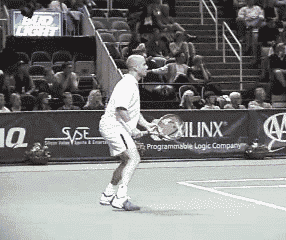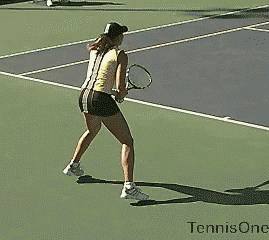|
TennisOne Lessons Biomechanics for Dummies: Nature or Nurture Sports science is a modern phenomenon, which has been instrumental in dispelling long-held myths and in validating the modern approach to hitting tennis balls. In this first section of my three part series, I will exam the science behind sports and the feasibility of the ‘perfect’ swing. Sports Science is increasingly becoming a major force in the sporting arena and tennis is no exception. While it is usually true that knowledge is power, the old adage, ‘paralysis by analysis’ is a constant reminder for coaches and players to temper the use of all this new information with effective methodologies for assimilation in the learning process. Tennis professionals are being encouraged more and more to embrace the latest scientific knowledge or risk being labeled ‘unprofessional’ or old school. Certainly, there are teaching professionals who are old school, which means they are holding onto the ‘science’ of yesterday and these individuals need to drop their defensiveness and realize that their teaching myths have been exposed by superior technology.
However, as important as it is to keep abreast of the latest scientific findings and as exalted a position that science generally holds in modern day society, it would, perhaps, be wise to remain open and explore an alternative option. An option that, dare I say it, goes beyond science. As intelligent as the best scientific minds are, I am suggesting that they are not quite as all knowing as the innate wisdom within our own body/mind/spirit organism. Can we let go of all we know or don’t know and trust this innate wisdom? Simply because this wisdom is not logical in the common understanding of that word, does not make it any less true. Is it possible to be fully aware of the latest sports science research and yet not avail of it, without being accused of being ignorant, out of touch or old fashioned? Have we simply gone from one extreme (knowing very little) to the other (knowing too much, or at least, more than we need), without finding the middle path? What is a sincere, hard-working, well-intentioned tennis teaching professional or player to do? How much should we trust sports science? How much of learning and excelling at tennis is ‘nature’ and how much ‘nurture?' In 1974, Timothy Gallwey set the teaching industry on fire with his book, The Inner Game of Tennis . Tim seemed to be arguing vehemently for the ‘nature’ side of the argument. Tim’s theories steadily lost favor with the mainstream teaching industry that is, if they were ever really embraced. The present emphasis on sports science is born from a desire to get some kind of edge in the very competitive sporting environment that we live in. There are huge rewards at stake for both players and coaches. Is there an edge to be had and does sports science hold the key? These and other questions are worthy of a closer examination.
How does sports science work? Great forehands, backhands and serves have been around for a long time; they were not invented by sports science. Solid technique existed even before a more scientific approach to tennis allowed us to analyze and understand a little better how players were hitting the ball. In other words, apples fell downward from the branches of a tree before Newton proclaimed his theory of gravity. However, supporters of the ‘nurture’ camp argue that before sports science arrived on the scene, players and coaches were simply shooting in the dark and misinformation ran rampant, with only the very talented rising to the top of the sport. Now, it is argued, with the need to touch a much broader base of individuals playing the game, this information is crucial to expediting the learning process, not only for beginners and intermediates, but also for professionals. They also argue that in days gone by, the sport was not as competitive as it presently is and that now aspiring professionals or top juniors ignore the latest sports science research at their own peril. So what can sports science teach us? There are two major considerations: the first is the issue of finding the ‘right’ way to hit a ball to maximize the desired combination of power, direction, spin, consistency and finesse through the study of biomechanics, if there is such a thing; and the second is to identify the relationship between this information and the learning process. In Search of the Perfect Swing Is there such a thing as the ‘perfect’ swing? What does the perfect forehand look like? Is it open or closed? How big should the loop be? What about the follow-through, where should that finish? Can we create the perfect bionic tennis player in a lab? These are difficult questions to answer; not because physics is not clear on the laws that govern power and spin. Not even because there is any dearth of information on the human anatomy and how the muscles and joints function, but because we are dealing with players who are individuals, situations which are unique and intentions that vary. These individuals have great similarities in their physiology and psychology, but also, distinct variables that make each individual wonderfully distinctive. In addition, an individual player may find him or her self in a variety of different situations, which may require varied responses. And finally, players have different intentions in different situations and at different times. Consequently, style of play and perhaps even choice of stroke mechanics arise in a diverse manner. Should every one hit the ball in the same way? Is there just one ‘right’ way to hit a ball? If not, on what basis do players choose how they will hit the ball? Do they actually choose, or do things happen at random or by some ‘divine’ guidance? Are these choices important? Does it really matter what grip a player hits with in the big picture? Is an effective stroke only possible with one type of grip? It should be obvious to the even the most conservative sports scientist that successful tennis players come in all sorts of shapes and sizes and hit balls in a variety of ways. Can a player be hugely successful and effective and still be ‘wrong’? What criteria are we going to use for ‘correct’ technique and will they come from the laboratory or the tennis court?
Unquestionably, laws of physics exist in the universe that seem impossible to violate without consequence, but in hitting a tennis ball, there are also unique individuals and situations involved in the equation and these are not so constant or easy to understand. If sports science is to play an important role in the development of tennis players, then there are numerous variables to be considered and these variables exist on physical, psychological, spiritual and situational levels. Is sports science able to consider all these factors? And if we can only garner partial information, can we temper our understanding with the possibility that we could be wrong or that other options exist at this particular moment in time, with this particular player in this particular situation? Knowing that we can be wrong is an important aspect of being a good coach or player because it leaves one open to at least the possibility of learning and growing more. Certainly, through the study of biomechanics we know many things such as that power equals mass multiplied by acceleration. This tells us that racquet head speed is an essential component of power. In addition, we know that the body is like a kinetic chain and that efficient and total use of this kinetic chain can help us maximize racquet head speed. In addition, we know many things about how spin is generated and how we can best use this spin in different situations for different purposes. There are numerous other such factors that are relevant to understanding the biomechanics involved, however, given the broad parameters outlined by this study there seems to be ample room for individuality to flourish. Certainly, general laws governing the physics of hitting a ball cannot be violated without detrimental consequence, but within such boundaries there seem to be numerous preferences or stylistic nuances that all seem to work. Amazingly, individuals, especially talented athletes, seem to find efficient ways to hit the ball without studying biomechanics through being relaxed, but more on this later. Another question to be considered is how important is technique in realizing one’s full potential as a tennis player? There are world-class players who have hit the ball in a variety of ways in the past 50 years; there have even been champions with major weaknesses in their games (Connors’ low forehand, Borg’s volleys, Sampras’ backhand, Graf’s topspin backhand, to name just a few!) It has clearly been illustrated that strokes that are less than picture-book perfect can still be effective enough to succeed in the overall picture of winning at the highest level. Consequently, how important is ‘ideal’ technique in the greater scheme of creating a tennis champion or even just a better tennis player? What are the other qualities that will ultimately determine how good a player can become and where does ‘perfect’ technique fit in overall importance in the greater scheme of things? Additionally, it is interesting to consider if these players would have been as successful as they were without their weaknesses. Did their weaknesses force them to develop other aspects of their game to compensate? And was their success due to their superb strengths or their lack of weaknesses? Has any player been able to do it all? Even Federer, perhaps the most complete and well-rounded player of all time hardly ever serves and volleys and rarely comes into the net during a point. Would he be a better player if he could? Undoubtedly he would, but is it possible to be good at everything? The truth is that in the past most champions have had a distinct style of game and exceptional weapons upon which they have relied on heavily for their success. Perhaps, the better players in the future will be able to do it all and be equally proficient at every aspect of the game; certainly Federer is an example of a huge step in that direction. Let us assume, for argument’s sake, that ideal technique does exist and is an essential part of success, the question then arises how do we achieve this ideal technique? The irony is that the more we give up the concept of ‘perfect’ technique and just relax and play, the more likely we will be to have players play with free swinging strokes that are biomechanically sound. And the more we try and teach specific movements through activating the mind, the more tension will be created in the body, which in turn will lead to poor technique. It may not sound very logical, but that’s the way it seems to be. So, how can we best use the information provided to us by sports science?
Presently, sports scientists are studying the top players in the world and analyzing what they are doing and then offering this information for coaches and players to learn from. However, most of the players that are being analyzed came to what they are doing instinctively and very often were not ‘taught’ these very same things that they are now being used as models to teach. Sports science can bring us to the ballpark; it can provide some broad parameters within which each individual can develop their own feel through an open and playful exploration. But as far as an exact blueprint of where each leg or arm should be positioned at each juncture of the swing, it fails miserably as a teaching methodology. Ironically, one of the most effective teaching aids, along with developing one’s own feel for the ball on the racquet, are visual images: the ability to see players moving smoothly and gracefully and hitting the ball efficiently. Intellectual analysis through the mind does not seem to help players perform better, what seems to work best is simple observation, which creates intention, followed by the opportunity to go out and practice by hitting lots and lots of balls. There is a huge difference in learning that takes place through the conscious mind and learning that takes place instinctively. When the conscious mind is involved in learning, the process is more labored, more mechanical. Also, the fact that it has come through the mind, the student feels that something has to be remembered and this desire to remember activates the mind and impedes free-flowing movement and relaxed swings at those very times when we need them most. Conversely, when learning happens more instinctively, the movements are invariably graceful and fluid and the student has no sense of the need to remember anything at all because mind is not involved and memory is a function of the mind. He or she simply plays in a let-go.
Is it possible to help players find ‘correct’ technique without an abundance of technical information? I think it is! Good technique is generally a function of being relaxed. The human body when relaxed moves in a certain way. Joints and muscles are remarkably similar in their functioning amongst most players. Certainly there are differences pertaining to strength, speed, flexibility, agility, stamina, eye-hand coordination, etc., but in general physiology, the similarity of joints and muscles and their functioning is remarkable. When an individual is relaxed, he or she will move gracefully and strike the ball efficiently. ‘Bad’ technique is almost always a function of tension; this is clearly illustrated with beginners and many club players. And once muscle memory has set in, as any experienced teaching professional knows, change is extremely difficult to facilitate, especially if tension persists. Here are two examples of situational variables that may have played a factor in determining recent trends. Years ago most tennis (three of the four Grand Slams) was played on grass where the ball bounced very low; is it a coincidence that the vast majority of players at that time played with a continental forehand grip, a grip ideally suited for succeeding on that surface? It is not that all players were taught this grip, but the vast majority of players picked it up anyway. Later, synthetic hard courts came on the scene and more and more players instinctively began dealing with the higher bouncing balls with semi-western and western forehand grips. Grips, perhaps not coincidentally, ideally suited for hitting higher balls. Or perhaps the extreme grip change phenomena was initiated by players starting to play at a younger age when they were physically shorter and the grip change was the only option that allowed them to hit balls that bounced around their shoulders. Regardless, I am not aware of any conscious movement by the teaching industry to initiate this mass grip change movement (actually the opposite is true, many coaches opposed the extreme grips and struggled to understand the change that was happening right in front of their eyes) and yet it happened. This appears to be an example of a major trend, especially in tennis, of science following, not leading the ‘natural’ intelligence of the body.
It seems that science very rarely initiates change as a leader or pioneer, at least as far as tennis is concerned; instead, it simply observes the changes that have already been made and at the most brings some kind of explanation for this change to the masses. For example, open stance forehands have been around for a long time, although sports science and the teaching industry have only recently (7 or 8 years) begun talking about them. Even now their acceptance is less than total as older, traditionalist (old school), teaching professionals only begrudgingly concede that sometimes they can be used, but that turning to the side and stepping in are still the preferred method of execution when sufficient time is available. This despite the fact that almost all professionals hit open almost all the time and even when they do turn sideways, they almost always are open when the swing is finished, since there seems to be little doubt that hip rotation is essential for maximum power. The only exception seems to be the short balls, when players seem to reach in to hit, which, not coincidentally, are shots not hit with maximum power. For me, the interesting thing is not that players are hitting open and had been for years before the mainstream teaching industry recognized this, but how these players learned how to hit open in an era when no one was teaching it? Not only was no one teaching it, but coaches were teaching something diametrically opposite. So how was it that players ‘instinctively’ found the most effective way to hit a ball? The truth is that players with continental forehand grips in the 1940s and 50s were hitting open. I suspect this was happening earlier also, although my personal library does not allow me to verify that. Advocates of sports science may argue that this is a perfect case in point where if sports science had been more advanced earlier, this fallacy of turning to the side and stepping in would never have lasted so long. However, for me, what is interesting is that the wisdom within the human body was instinctively able to find the most efficient way to increase racquet head speed and hit harder, without guidance from outside sources. The body found the most efficient way to hit the ball, all it needed was the intention; in this case, the intention was to hit harder or with more spin. Turning to the side and stepping in is fine if you want to simply keep balls in play and hit basically flat, which is primarily all you can do with a continental forehand grip, but if you want to move most efficiently and hit with topspin or maximum power, which requires greater racquet head acceleration then you will have to hit more open. Great athletes discovered this all by themselves; no sports scientist had to tell them. The serve is another concrete example of this pattern of science following the instinctive and innate wisdom of the human body. Before Vic Braden and Howard Brody armed with their high-tech cameras and slow-motion features discovered that the forearm actually pronated on the serve, every player I asked, from professional to beginner, had no idea what path the racquet took on a serve. No one can be blamed for this; it is almost impossible for the human eye (the earlier tool of choice for science) to see pronation; almost all coaches and players believed that the arm simply came across the body. Again sports scientists would argue that is it not wonderful that now we have the technology and understanding to know exactly what the arm and wrist do during a serve so that we can teach it to others? Yes, it is obviously good to have this information, but yet again, what is more interesting is that almost every advanced player ‘instinctively’ pronated while serving in an effort to maximize spin and power; this despite the fact that they were not only not taught how to do this, but had no idea that they were doing it! The body instinctively knew what to do, before the mind even realized what it was doing. The intriguing consideration is: will players find it easier or harder to serve efficiently and effectively knowing what pronation is?
Another obvious example of the incredibly innate intelligence of the human body revolves around the teaching cue, ‘take your racquet back quickly’. For years this was the cornerstone of accepted teaching ‘wisdom.’ Regardless, no ‘advanced’ players seem to do this (with some notable exceptions who undoubtedly pay a heavy price in terms of a lack of consistency). Amazingly, this cue is still heard today on courts around the world! How did this happen! How did players ‘know’ that to take the racquet back slowly is more effective than to run to the ball with the racquet back? Obviously, this knowing was not at the level of the logical mind because it makes sense to think that the quicker you take the racquet back the more time you will have to hit the ball, but unfortunately Life is not logical! The point is that despite constant wrong instruction, the human body instinctively found the ‘right’ way to hit the ball. This is especially true of talented athletes who have a greater tendency to let-go and trust their own bodies than their non-athletic counter-parts, who will diligently follow instructions. The irony is that if you tell players nothing about how to get the racquet back they will automatically and instinctively take it back slowly, but the incorrect cue of taking it back early has made this a more difficult sport to learn how to play. I am not advocating an abolition of the entire sports science wing of the tennis fraternity; on the contrary, much of the information is important and helpful in ways that are not always easy to discern. This is especially true in reference to fitness and the workings of the human body under physical stress, conditions that take the body outside of its ‘natural’ comfort zone. Although even in this field, opinions differ amongst various ‘experts’ and ‘scientific facts’ are constantly getting updated and in some cases what was once thought advisable is now considered harmful. Sports science can and does provide us useful information about the biomechanics of stroke production, but how we use this information to embellish the learning process is key. It is almost as if we, (as coaches) need to know all that sports science provides us, but then not allow this knowing to interfere with our facilitation of the learning process; if what we ‘know’ is correct then the human body will find it naturally all by itself. All coaches need to do is facilitate this natural process with a few gentle prods here and there. Just telling players all that we know does not seem to be the most successful teaching methodology; in fact, often it can create obstacles to the learning process. Just a few short years ago; the purists (some of the most respected coaches in the world) hated and ridiculed the extreme grips that are the rage today. Those very same coaches are now singing an entirely different tune and the science of yesterday has been abandoned for the science of today, without missing a beat. None of the past experts have been held accountable and neither will the present ones, when something else comes along and another shift occurs. Stay tuned! Your comments are welcome. Let us know what you think about Happy Bhalla's article by emailing us here at TennisOne.
Happy Bhalla has written two books on tennis: 'Relaxed Intensity' and 'Instinctive Tennis'. The books can be purchased directly from the author by emailing him at happybhalla@hotmail.com |

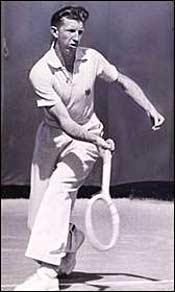
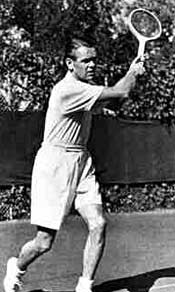
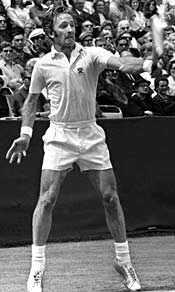 Before there was any real sports science, players like Don Budge (left), Jack Kramer, and Rod Laver still achieved greatness and dominated the field.
Before there was any real sports science, players like Don Budge (left), Jack Kramer, and Rod Laver still achieved greatness and dominated the field. 
